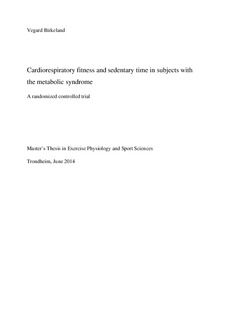Cardiorespiratory fitness and sedentary time in subjects with the metabolic syndrome: A randomized controlled trial
Master thesis
Permanent lenke
http://hdl.handle.net/11250/264913Utgivelsesdato
2014Metadata
Vis full innførselSamlinger
Sammendrag
Metabolic syndrome (MetS) is an increasing health concern worldwide. Low cardiorespiratory fitness (CRF) and high amount of sedentary behaviors are strongly associated with the MetS and cardiovascular disease (CVD). Aerobic interval training (AIT) has been found to improve CRF more than continuous moderate exercise (CME) for subjects with MetS, and other groups of patients. However, strategies for decreasing sedentary behaviors are inconclusive and it is unclear whether CRF can be connected with sedentary time. Objective: The purpose of this study was to compare the effect of CME, low-volume AIT (1-AIT) and high-volume AIT (4-AIT) on total daily sedentary time (TDST), peak oxygen uptake (VO2peak) and the components of MetS, in subjects with the MetS. Method: 32 subjects with MetS were randomized into three groups: CME (n=11), 1-AIT (n=9) and 4-AIT (n=12). All groups underwent 16 weeks of exercise. Results: No significant within or between groups differences (p>0.05) of TDST or VO2peak were found. The components of MetS showed no significant difference (p>0.05) between the groups. Within the groups, only HDL in 1-AIT improved significantly (p<0.05). The findings indicated no correlation between VO2peak and TDST. Conclusion: After 16 weeks of exercise, no significant differences in TDST, VO2peak or components of MetS were found between the groups. The results suggest that there is no connection between CRF and sedentary time. However, the findings may be biased on several levels and must therefore be interpreted with caution.
